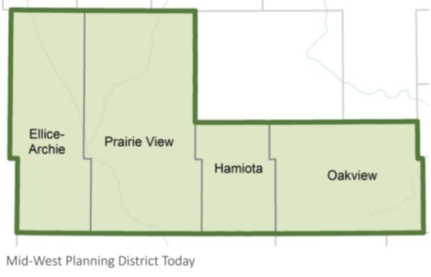The Mid-West Planning District Board operate under the authority of the Planning Act and it consists of an appointed Board of Directors comprised of member municipal Councillors who are appointed by their respective member Councils’ to serve as Directors and Alternates of the Mid-West Planning District Board.
Member Municipalities
Mid-West Planning District consists of four member municipalities:
- Rural Municipality of Ellice-Archie
- Prairie View Municipality
- Hamiota Municipality
- Rural Municipality of Oakview
The Mid-West Planning District is responsible for:
- Building Inspections
- Permits (building, demolition, plumbing, moving, signs)
- Planning (conditional uses, development plan amendments, rezoning and variations)
- Zoning Memorandums
- Fire Safety Inspections

The Mid-West Planning District is responsible for the administration and enforcement of each member municipality’s municipal building by-law.
The administration and enforcement of the Manitoba Building Code and Standards is also a responsibility of the Planning District.
Board of Directors
The Mid-West Planning District is governed by an eight-member Board of Directors consisting of two representatives from each of the municipalities.
The Board of a Planning District shall:
- Adopt a District Development Plan
- Issue Building & Development Permits
- Hear local zoning appeals
- Comment on subdivisions to member Council(s) and the Province (Manitoba Municipal Relations [MR])
A History of the Mid-West Planning District: 1997 – 2017
The early beginnings of the formulation of a planning district began circa 1997 when several municipalities with similar interests entered into discussions with the Manitoba Department of Rural Development to investigate the possibility of each municipality establishing a municipal planning program or several municipalities working together collaboratively to form a planning district that would adopt a single district-wide land use plan with individual member municipal zoning by-laws.
During the fall of 1997 and the winter of 1998, the Councils and a subcommittee of Councils of the rural municipalities of Woodworth, Saskatchewan, Hamiota, Blanshard, Town of Hamiota and Town of Rapid City passed resolutions in the spring and summer of 1998 to authorize their municipalities to join a planning district, the Town of Rapid City decided at this time to step anyway from participating in the establishment of the planning district.
On May 11, 1998, the Rural Municipality of Miniota Council, and the head of Council, Reeve Larry Walker, passed a resolution authorizing the municipality to join with the Rural Municipalities of Woodworth, Saskatchewan, Hamiota, Blanshard and the Town of Hamiota to form a planning district and submitted an application to the Minister of Rural Development seeking his approval to formally establish the Mid-West Planning District..
As part of the Ministerial application process, in October 1998 those municipalities wishing to establish the Mid-West Planning District prepared, with the assistance of the Brandon Regional Office of Community Economic Development of Manitoba Rural Development, a submission to the Manitoba Municipal Board with a proposal to establish a the Mid-West Planning District
The proposed member municipalities of the Mid-West Planning District were notified on January 29 1999 that the Government of the Province of Manitoba had approved Order in Council 621/1998 (dated December 16, 1998), which lawfully approved the establishment of the Mid-West Planning District.
The establishment of the planning district was a quite an undertaking for the Councils of the day, as the idea and basic principles of land use planning were in their infancy and these decisions may be considered to be forward thinking and progressive for the time. It should be noted that when the Mid-West Planning District was established, land use planning in Manitoba at the local level was discretionary and didn’t become mandatory until 2006.
The Planning Act provides a framework for land use planning at the provincial, regional and local levels. Manitoba has had Provincial Land Use Policies adopted by Regulation since 1980. The current Provincial Planning Regulation (MR 81/2011), containing an updated set of Provincial Land use Policies came into effect in 2011.
The work of putting together the administrative framework for the Mid-West Planning District began on March 11, 1999, the inaugural meeting of the Mid-West Planning District Board.
In 1999-2000, the primary activities of the Mid-West Planning District Board were, with the assistance of a private planning consultant, start crafting a district development plan and six (6) municipal zoning by-laws (one zoning by-law per member municipality), the appointment of a Development Officer and to secure office space.
In September of 1999, The Mid-West Planning District Board applied for provincial cost-shared funding assistance through the Community Planning Assistance Grants program to offset the capital cost to the board and its member municipalities in the development of a district land use planning program (i.e. a background planning and engineering study, a district development plan and six (6) municipal zoning by-laws). On August 10, 1999, David Lettner and Associates/Cochrane Engineering were retained by the Mid-West Planning District Board as a consultant to formulate a Background Study, a district development plan and six (6) municipal zoning by-laws.
The Mid-West Planning District formally adopted its first Development Plan by a By-Law on June 5, 2001 (By-law No. 4-2000). After the Development Plan was adopted, each member municipality within the planning district then drafted and enacted a municipal zoning by-law, which set out specific regulations for land use and development in their respective municipality.
On May 4 1999, Wayne J. Poppel, who was at that time the Building Inspector for the RM of Miniota (since 1998), was hired as a Building/Plumbing/Fire Inspector/Development Officer for the Mid-West Planning District, with the planning district office located in the inspector’s residence. He also assumed the duties of the Secretary Treasurer of the planning district in 2001.
The arrangement to have the office located in the Development Officer’s residence came to an end when the newly renovated and expanded R.M. of Miniota office was completed. The move was made in June of 2012.
MID-WEST PLANNING DISTRICT RE-ORGANIZATION (2015)
As a consequence of municipal amalgamation initiated by the provincial government in 2014 and which became effective on January 1, 2015, many changes have occurred at the local level related to municipal organization and administration. Municipal amalgamation has also affected many planning districts in Manitoba, in some cases existing planning districts have had to re-organize, grow or shrink in size and in other cases existing planning districts have dissolved.
In 2014, planning districts affected by municipal amalgamation were notified by the Province that changes in municipal boundaries resulting from municipal amalgamation would trigger the need for affected planning districts to re-organize to reflect municipal re-structuring and to maintain authority to continue to provide planning and development advisory services in 2015.
The re-organization process for the Mid-West Planning District was initiated in 2014 and became effective on the same date as municipal amalgamation became effective on January 1, 2015.
As a consequence of municipal amalgamation, and in order for the Mid-West Planning District to continue to have authority to provide planning and development services to existing and newly joining municipalities, those municipalities wishing to become part of a geographically expanded planning district made application to the Mid-West Planning District Board to join the Mid-West Planning District. After acceptance by the Board in 2014, the Minister of Municipal Government also gave his approval to expand the territorial limits of the Mid-West Planning District on December 31, 2014 just prior to the effective date of municipal amalgamation on January 1, 2015.
The Mid-West Planning District (January 1, 2015): Six (6) municipalities joined the Mid-West Planning District and the RM of Woodworth departed from the District (choosing to become part of the Trans-Canada West Planning District on December 31, 2014) thereby increasing the total number of member municipalities in the Mid-West Planning District to eleven (11) in 2014. As a consequence of municipal boundary realignment resulting from municipal amalgamation which became effective on January 1, 2015, there are now a total of four (4) municipalities comprising the Mid-West Planning District on January 1, 2015 as follows:
Member Municipalities:
- Rural Municipality of Ellice-Archie (Formerly: RM of Archie, RM of Ellice, and Village of St. Lazare)
- Prairie View Municipality (Formerly: RM of Birtle, RM of Miniota, and the Town of Birtle)
- Hamiota Municipality (Formerly: RM of Hamiota and Town of Hamiota)
- Rural Municipality of Oakview (Formerly: RM of Blanshard, RM of Saskatchewan, and the Town of Rapid City)

On January 22, 2015, The Planning Districts Regulation 249/2006 was amended by Regulation 16/2015 which formally recognized the newly re-organized Mid-West Planning District.
Being one of the largest planning districts in the Province of Manitoba with the district comprising 36 Townships (1296 sq. Miles) with a population of 5939 (2015 census), has created many new challenges for the re-organized and expanded Mid-West Planning District. As a consequence of municipal amalgamation and planning district re-organization in 2014 and 2015, the Mid-West Planning District has almost doubled in geographical area.
The Mid-West Planning District is recognized as being a model rural planning district in Manitoba with a reputation for being very good at providing service to its member municipalities and the development community therein. Going forward, with the co-operation of member Councils, the Board of the Mid-West Planning District and its staff, should continue to serve the public well into the future.
